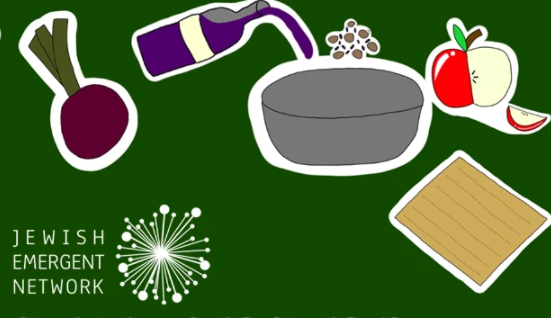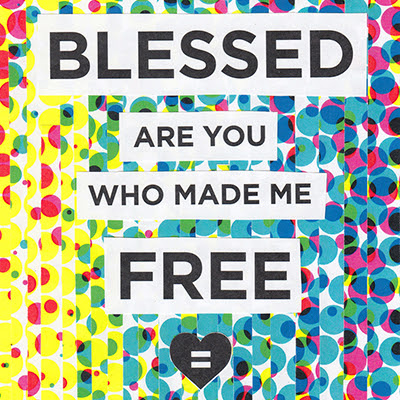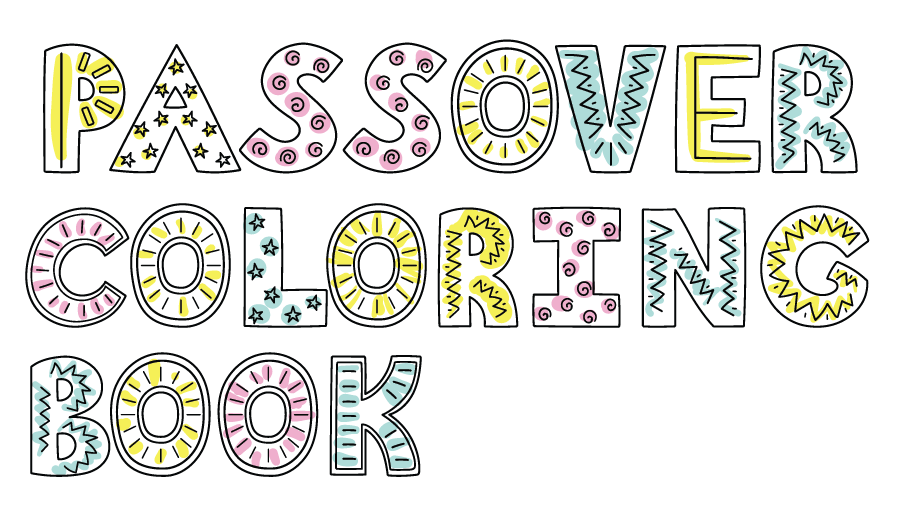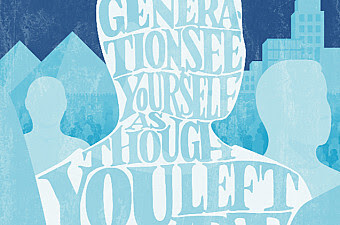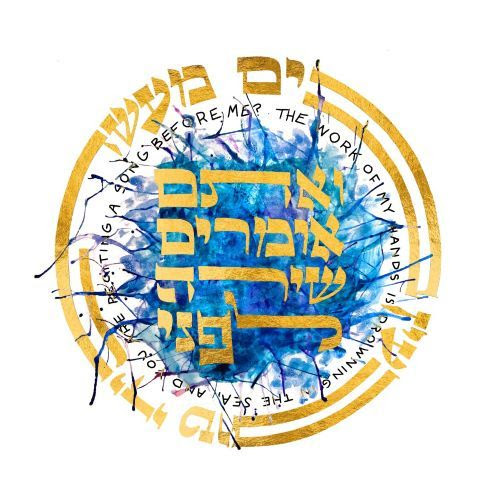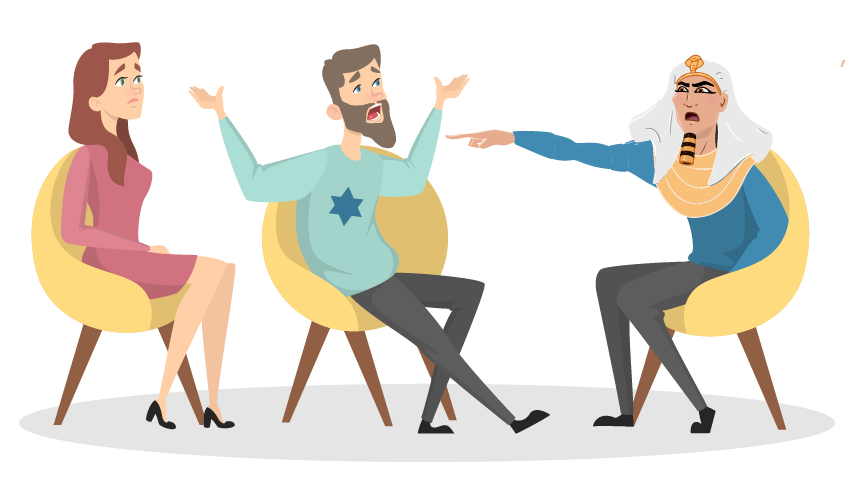April 12, 2022
Posted by Haggadot
Hey Passover Pals! Get ready to laugh out loud at your seder when you download our updated Comedy Seder. Or add jokes, parodies, skits & games to any haggadah and bring the funny. |
 |
|
|
|
We're making it easy for you to bring the best of our site to your family's seder with our 2022 Favorites Haggadah |
 |
|
Highlights From 2022 & Throwback Favorites9 Easy Seder ActivitiesSunflower Seeds On Your Seder PlateFour Passover Shabbat QuestionsA Personal Coming OutFinding Meaning
|
April 08, 2022
Posted by Haggadot
Join Rabbi Arthur Waskow and Rabbi Phyllis Berman from the Shalom Center as they guide us through new Tellings of the Haggadah, looking back at history and at the call for earth justice in our current moment. Together, they’ll share insights into their new Earth & Justice Freedom-Seder challenging the Corporate Carbon Pharaohs, the Iftar-Seder bringing together Muslims and Jews as Passover and Ramadan coincide, and the impact of the Freedom Seder more than 50 years later.
Explore the offerings of the Shalom Center, including the 50th Anniversary Interfaith Freedom Seder, the Freedom Seder for the Earth and the new version of Let My People Go sung by Rabbi Waskow.
April 07, 2022
Posted by Haggadot

April 01, 2022
Posted by Haggadot
Go on an excellent adventure with pop culture expert Esther Kustanowitz, journalist and Star Trek superfan David A.M. Wilensky and Jewish sacred texts superfan Rabba Yaffa Epstein. Watch the We Could Be Heroes webinar here!
Download the Heroes Haggadah for your seder: https://www.haggadot.com/haggadah/heroes-haggadah
Together, we considered 4 Questions:
Why do we love superheroes?
Why might we embrace rituals that make room for battle and connections to the infinite?
What are our responsibilities to worlds outside our own?
How do today's stories intersect with our classic texts and shared history?
And we discussed:
- The dichotomy of a hero (such as Superman) being both human and superhuman at once. And how their human side is flawed, and their superhuman side learns to utilize those flaws and skills together
- Is every leader a hero? Does one have to take on the mantle of a hero to be a leader? Are the winners always the heroes?
- Is a show like "What If" a modern form of midrash and is midrash a multiverse?
- When we tell the Exodus story over and over, we can be the heroes bringing justice for those who need it
March 31, 2022
Posted by Haggadot

By Dubbs Weinblatt
A few years ago I partook in a Jewish ritual where I changed my Hebrew name to something that fit me better: Pesach Feigele. I borrowed a word from my parents’ Hebrew names; Pesach from my dad and Feigele from my mom. Feigele is Yiddish for ‘bird’ and iterations of it have been used as a derogatory slur against LGBTQ+ people – I decided it was important to be part of the movement to reclaim the word and I loved the idea of being free like a bird. Pesach, which is Hebrew for ‘Passover,’ also felt significant to me. Passover is a holiday that celebrates many themes, two of which are liberation and the importance of telling our stories.
I was recently on a road trip with a friend where we plugged in our destination’s address which popped up immediately, hit go, and we were on our way. We didn’t even second guess where we were going. We talked about how if it had been 20 years ago, we’d have had to print out our directions, pray there were no detours or missed exits, and hope for the best. Getting from point A to B nowadays is so much easier because of the tried-and-true routes and road conditions that are instantly updated and uploaded for the benefit of all travelers. Roadmaps help create a sense of visibility into our journey so we feel confident about where we’re going.
When I think about roadmaps, stories, and visibility into Trans and Nonbinary/Genderqueer identity, and especially Jewish Trans identity, it takes a little while longer to load. There haven’t been enough folks uploading their experiences to the information highway yet for the representation to just “flow.” Though trans and nonbinary/genderqueer people have existed since the beginning of time, for so long it hasn’t been safe to be out and talking about it, or our history was erased. I always found myself asking the same question over and over: where can I find the permission to be myself; where’s my roadmap?
Growing up without any concrete sense-of-self created a Mitzrayim, a narrow place; everything felt dark and hopeless and like there was no escape. Because I didn’t even really understand that I was struggling with my gender identity, I took what I needed from the representation that existed to help me feel a bit more like me. My liberation felt impossible. I thought I was going to be stuck in this narrowness forever.
When I was younger and privately exploring my gender (though I didn’t realize that’s what I was doing), I used to wear a California pink polo (is that a thing? I think I made it up), pretended my scooter was a motorcycle, and that I was a blend of Brandon Walsh and Dylan McKay from Beverly Hills 90210. I felt so at home and at ease playing this hybrid character even though I didn't know what it meant. I also dabbled in Zack Morris from Saved by the Bell, a hybrid Shawn Hunter and Cory Matthews from Boy Meets World, and Joey Russo from Blossom….WHOA.
I remember one of the first times I saw trans representation in mainstream media – I was in high school watching a movie in the late 90s called Boys Don’t Cry about a young trans man in rural Nebraska. I saw parts of myself in this character – not fully, but parts which felt incredible, mesmerizing, and also terrifying.
It was all immediately ripped away by the violence perpetrated in the film. I internalized that if I were anything like this man, there would be very dangerous consequences. This movie taught me to tuck away any feelings I was having so I could stay safe. My narrow place was getting narrower.
I had to wait more than a decade until I saw (or even registered) more trans/nonbinary/genderqueer representation/glimpses and even then, nothing that screamed “THAT’S ME!” It felt as if I was wandering in the desert searching for my own Promised Land of identity.
Each one of those glimpses into myself and my identity came in different forms and started carving away some of the narrowness. These moments included trans characters (whether or not they were portrayed by actual trans people is another article) and some were gender expansive in some way.
Seeing Lea DeLaria wearing a sports bra and boxer briefs in an Orange is the New Black episode was revolutionary for my gender identity exploration. I didn’t know I was allowed to wear sports bras all the time or boxer briefs ever. I know it might sound silly but I was so used to following a set script of who I was supposed to be that I couldn’t break out of it – I simply didn’t have access to what could be.
The stories we are told become the stories we tell ourselves. This drives our sense of self, and that’s powerful. But what happens when the story that’s being told to us isn’t actually our story at all? What happens when it is?
The show Transparent was crucial in me seeing myself as not only a trans person but as a Trans Jew. It made coming into myself and telling my family that much easier knowing I had something concrete I could show them. I wasn’t alone. I wasn’t weird. This wasn’t unique to just me. Finally a story was being told to me where I felt like it was mine and I could retell it as my own.
For most of my journey, I had to create my own roadmap, my own story, because I had no choice. My liberation was in my own hands. I took what I needed from what was available and improvised the rest. Eventually through community, a reconnection to Judaism, and a lot of self-reflection and work, my narrow place became a wide-open field full of light, love, connectedness, and inner peace and calm.
The more we tell our stories and share our experiences, the easier it is for all of us to be liberated and to find our own open-fields. On this Trans Day of Visibility, I wish for all of us the roadmaps we need to find our own inner-liberation with just a bit more calm, connectedness, and ease.
About the Author: Dubbs Weinblatt (they/them) is the Founder and CEO of Thank You For Coming Out, a company that strives to inspire authenticity and belonging by uplifting and centering LGBTQIA+ stories and identities. They are also an educator, coach, podcast host, and storyteller.
March 16, 2022
Posted by Haggadot
|
|
|
|
March 08, 2022
Posted by Haggadot
Women play a pretty important role in the Passover story. Shifra & Puah were midwives who protected Hebrew babies. Without Miriam, Yocheved and Pharaoh's daughter, Moses could not have led the Hebrew slaves out of Egypt. And while Ruth Bader Ginsberg isn't a Biblical character, she has written about the women of Passover.
|
 |
|
Our Feminist Favorites For Your Seder
|
Our Pre-Passover Tip of the Week: Embrace Vulnerability
|
|
March 07, 2022
Posted by Haggadot
By Julee S. Levine
On Pesach, we open the door and proclaim, “all who are hungry, let them come and eat.” We open the door to welcome Elijah, as a sign of hope and faith. The seders I attend each year (and Gd help me if I miss them), open their doors for different reasons. They open the doors of accessibility. It is one thing to be hungry for food to eat, and it is another to hunger for connection, inclusion, and ownership. At these seders, that is why we open our doors.
On the first night of Pesach, my husband, my mother, and I are with our friends, the Glick Family. Over the last 20 years, we have become “framily”, and Mrs. Glick tells me that it isn’t Pesach without us there. We’ve had years where the table was very full, and years where things were smaller and a little slower, but always just as warm and meaningful.
There was the year we got the call towards the end of the seder that Mr. Glick’s mom had died, and the rest of the night was a mix of trying to reach a rabbi, clean up the meal, and let our friends try to adjust to their abrupt and unexpected loss. Their adult daughter, Sari, has become less engaged with formal Judaism over the years, and is a passionate advocate for those who are marginalized, especially individuals with disabilities. Their adult son, Jonah, is on the Autism spectrum, and until recently, had been labeled as “non-verbal.” It turns out that he is a Speller, which means that he can fully express what he wants to say through spelling out his responses using a communication board and partner.
This seder has always been about access and connection. Even in the years that it was assumed that Jonah was at a very low level academically and cognitively, nothing was ever pediatric. As Sari has begun challenging the words and actions of everyone around her, she embraces the need for asking questions. Mr. Glick still hearkens back to much of his Orthodox upbringing, and Mrs. Glick loves to scour the internet (and Haggadot.com) for new thought pieces, interpretations, and additions for their ever-changing Seder.
I love this seder because it is all about open doors and questions. Though the core guest list is the same every year, there are always new additions and there is always room for someone’s plus one or a last-minute friend who needs a place and a space. No question is off limits, and all responses are heard, especially the ones that are verbal. Each year, I leave satiated and still craving more. I don’t need anything else to eat, but my desire to keep discussing, debating, and learning has only just been piqued.
On night 2, we are with our friends Geri & Charles and their extended “framily.” Geri and I met in college more than 25 years ago and reconnected through Facebook, only to find we lived 20 minutes apart. The initial invite to their seder went like this:
I know that you work in Jewish education, and everyone does a long first seder. How about if you join us and do about 20 minutes of something creative and interesting…and I’ll feed you.
So, I sang for my supper, and year after year, I revel in the challenge of bringing new things to the group that are inclusive, engaging, educational, and fun.
Geri is Jewish, her husband is not. They celebrate a lot of holidays in their home, giving each its own space and recognition. Their extended circle includes several people who were born Jewish and who observe in various ways and come from a wide range of backgrounds. Some of the adults are married to partners who are not Jewish and who were not born in America. The guests at the “children’s table” are now in middle and high school.
The seders I craft for this night are based in inquiry and in the issues of the day. One year, I asked everyone to bring with them a symbol of their personal oppression, with the caveat that it had to fit in the palm of their hand. After they were all named, we placed them on a large plate, The Plate of Oppression, and they were removed – uninvited from our seder table. People also reflected that holding that symbol in their hand reminded them that too often, we are the ones who make our own oppressive states bigger than they are or need to be.
I love this seder because it really leans into the “all who are hungry” message. These wonderful people are both hungry for the undoubtedly delicious meal (hello, lamb vindaloo) and they hunger for learning and inspiration. I’m honored to have that be my contribution to the seder. Everyone else brings their specialties…from dinner to haroset to desserts. I bring the soul food…not greens and grits, but the pieces that nourish our souls together and that remind us that the doors should stay open, because all are truly welcome to feast with us.
About the Author: Julee Levine is the Director of Supplemental Education at Adat Ari El in Valley Village, CA. She is a career educator who has worked with almost all ages and stages in a variety of settings. When she is not seder hopping, you can find her engaged in professional development, immersed in sports, and competing on game shows (four and counting). She feels strongly about gefilte fish (jarred), matzo balls (firm), and horseradish (red).
Author’s Note: The names have been changed to maintain privacy.
Looking for Inclusive Content? Try these!
Haggadah for Adults with Disabilities
Inclusion Haggadah by Matan
GLBT Haggadah from JQ International
March 02, 2022
Posted by Haggadot
|
Happy Adar (Again) - Let's Make Room For Joy |
|
With everything happening in the world, finding joy can feel challenging. But in the month of Adar, which we celebrate for the second time this week, we're invited to find happiness, even in our darkest moments. We're making time to appreciate the small, special things in our everyday lives.
Our Passover Meditation Guide is a great place to start. |
 |
Pre-Passover Tip of The Week: Take Time to Savor |
|
Preparing Passover can feel stressful, but it can also be joyful. When you take the time to savor, you pause for a moment and just take it all in. Whether you're grateful for reuniting in person, for the sights and smells of the holiday or just for the return of a favorite time of year, savor it.
Download Our Favorites For Savoring
Mindfulness For Each Step of the Seder Passover Meditation Guide Embodied Practice Four Mental Health Questions. |
|
|
|
Savor the Season With Ready-To-Print Booklets
|
|
February 28, 2022
Posted by Haggadot

By Rabbi Evan J. Krame
My earliest memories of Passover Seders are of my grandfather mumbling Hebrew. The only interruption was a child singing the “di fir kashes” (four questions in Yiddish). I don’t recall seeing my grandmother during the seder because she was in the kitchen almost the entire night. Rather than the obligatory, rote and uninspiring Passover of the 1960s, liberate your seder! Here are some tips for a freer and more engaging seder in 2022.
The bowl of freedom. Here’s how to free grandma or other chefs from the kitchen. Write an activity related to serving the seder meal on a card or slip of paper. I like index cards. Put just one activity per index card. Create more cards than there are guests. The tasks written on the cards can be anything from serve the soup to put desserts on the table. Then, find a large bowl or box to put on the table. Place the cards inside. Invite everyone to take one or two cards. If it is a large table, pass the bowl around. Ask everyone to read their newly selected tasks out loud and be prepared to help with the meal at the right time. Everyone has an obligation to participate in the seder, so why not in the dining experience?
The wine of freedom. No more sweet concord grape wine. Open your wine fridge to some great wines that even oenophiles will love. Try a champagne for the first glass. Perhaps a dessert wine for the fourth glass. Our family loves a kosher for Passover fig arak to end the meal.
The chair of freedom. Our modern tradition is to gather at a dining room table, crowded and often uncomfortable. One of the obligations of the seder is to lean to the left in a show of ease and comfort. However, leaning to the left on a pillow can be a logistical challenge in the dining room. So how about moving the first half of the seder to the living area? Kids can sit on the floor while otherwise cranky aunts and uncles cuddle on the couch. Just remember to cover any furniture that would be ruined by some spilled beverage.
The story of freedom. The purpose of the Passover story extends beyond a historical exercise. It is a reminder that no people should be oppressed. So bring another story of oppression and freedom to your table. Offer that assignment in advance to one of your guests. For example, my Persian brother-in-law tells how he escaped from Iran. Or offer to tell the story of Harriett Tubman. Then invite everyone to discuss how that story of freedom relates to our exodus from Egypt.
The health of freedom. Staying healthy offers us the freedom to live our lives as we choose. Some are confined by illness. Others are released by medicine, therapy or surgery. After two years of a pandemic, how does our concept of freedom relate to illness and health? Or discuss how our nation’s devotion to freedom has been challenged. Is a healthy democracy the key to true freedom? Exercise caution here as you don’t want politics to derail a great seder.
Figuring out how to gather again requires a little bit of thought. As we are freed up to invite family and friends to our seders, liberate your seder into a brave new world!
About the Author: Rabbi Evan J. Krame serves the greater D.C. community as Rabbi of the Jewish Studio, focusing on bringing a joyful and meaningful Judaism to adults. Rabbi Krame is the founder of Jewish Doorways, an online resource for making life events meaningful. He currently serves as the President of the Washington Board of Rabbis.
----
Looking For A Haggadah For Your Freedom Seder? Try These!
Passover Meditation Guide
JewBelong Haggadah

 Snag our Megillah for your
Snag our Megillah for your  Better understand our community through
Better understand our community through  Download our Purim mask
Download our Purim mask  Shake up one of our favorite
Shake up one of our favorite 
